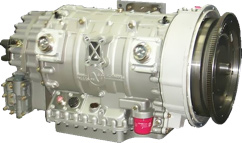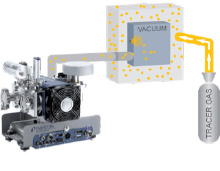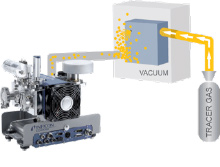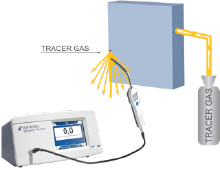Test di perdita su sistemi di trasmissione
Description of Technical Challenge
 Transmissions can leak, and due to the complex operation of newer multi-speed transmissions, leakage of transmission fluid can greatly affect shifting performance. Detecting leaks at the earliest stage of manufacturing, post-casting and pre-assembly, saves transmission suppliers, both internal and external, significant cash, and headaches due to customer complaints or, worst case, recalls. Historically many leaks are discovered at or after final assembly. Detecting leaks soon after the original casting step saves cost at this critical juncture by eliminating defective castings early in the build process.
Transmissions can leak, and due to the complex operation of newer multi-speed transmissions, leakage of transmission fluid can greatly affect shifting performance. Detecting leaks at the earliest stage of manufacturing, post-casting and pre-assembly, saves transmission suppliers, both internal and external, significant cash, and headaches due to customer complaints or, worst case, recalls. Historically many leaks are discovered at or after final assembly. Detecting leaks soon after the original casting step saves cost at this critical juncture by eliminating defective castings early in the build process.
Aluminum cast products may have, for instance, a one-inch diameter area that due to porosity leaks, has literally a trillion holes helium molecules can migrate through. Such porosity would never be revealed with air or underwater testing. Leaks do not necessarily look like cracks or perfect circular holes, rather they may resemble a cave-like system of cracks and pockets within the metal. Using air pressure, the requisite time to detect a pressure drop (needed to measure the low leak rates now required by automakers) might be days.
Currently, industry standard permissible leak rates are approximately 1 sccm —one standard cubic centimeter per minute. As transmissions evolve and become more complex, the internal fluids change, performance requirements are higher, and leak rates are lower.
The INFICON Solution
Leak testing the casting before further assembly
 Before leak testing, the casting needs to be sealed against a part-specific fixture. An INFICON LDS3000 Helium Leak Detector is connected to the interior of the casting through the tooling. The tooling and transmission are then inserted into a sealable fixture and the part is clamped, sealed and evacuated. Subsequently, helium is injected into the enclosure. Inside, fans agitate the air to create a uniform mixture of helium gas and air, creating a helium-air mixture (as low as 1% helium content). Any helium that migrates from the helium-air rich exterior to the interior, through porosity leaks, cracks, thread leaks, or any other pathways, then moves through the housing into the transmission to be detected and is quantified by the helium leak detector. At that point any pass / fail decision can be made, and data is collected for traceability. All passages are individually tested.
Before leak testing, the casting needs to be sealed against a part-specific fixture. An INFICON LDS3000 Helium Leak Detector is connected to the interior of the casting through the tooling. The tooling and transmission are then inserted into a sealable fixture and the part is clamped, sealed and evacuated. Subsequently, helium is injected into the enclosure. Inside, fans agitate the air to create a uniform mixture of helium gas and air, creating a helium-air mixture (as low as 1% helium content). Any helium that migrates from the helium-air rich exterior to the interior, through porosity leaks, cracks, thread leaks, or any other pathways, then moves through the housing into the transmission to be detected and is quantified by the helium leak detector. At that point any pass / fail decision can be made, and data is collected for traceability. All passages are individually tested.
Helium leak detection takes seconds with a total part-to-part test time of roughly 30-40 seconds.
Leak testing of assembled transmissions
 At a second stage, typically near the end of the production line, transmissions may again be tested, this time from the inside out. The testing chamber becomes a vacuum chamber and the finished transmission is sealed and tested. For this testing process, large vacuum pumps pull a vacuum once the chamber lid is closed and an INFICON LDS3000 Helium Leak Detector is valved into the vacuum pumps to identify helium molecules as they emerge from the finished transmission.
At a second stage, typically near the end of the production line, transmissions may again be tested, this time from the inside out. The testing chamber becomes a vacuum chamber and the finished transmission is sealed and tested. For this testing process, large vacuum pumps pull a vacuum once the chamber lid is closed and an INFICON LDS3000 Helium Leak Detector is valved into the vacuum pumps to identify helium molecules as they emerge from the finished transmission.
The part and chamber are evacuated simultaneously; subsequently the part is backfilled with helium. As seals in the part cannot take over a ~ 30 mbar (4 psi) differential, during inside-out testing the transmission itself is internally pressurized with 100% helium gas at ~ 20 mbar (3 psi). Helium then has the opportunity to migrate outwards—versus the previous inwards—if a leak is present.
The reason this testing is performed inside out is first, normally manufacturers desire to test within the design criteria of the item being tested. So, for an automatic transmission, fluid pressures are exerted from interior to exterior and modeling should replicate the condition of final operation. If, under pressure, passageways are squeezed, or joints expanded, helium can escape in the same manner fluids might leak. Second, because of the complex assembly—solenoids valves, torque converter, worm trail, and all the tortuous pathways—helium may be more rapidly passed into the vacuum if there are leaks. All passageways are tested for higher confidence of leak-free performance.
Leak location in castings or assembled transmissions
 After one or more leaks have been detected, the leak needs to be located in order to be repaired. For leak location, the transmission is filled with forming gas (a 5% hydrogen in 95% nitrogen mixture). The sniffer tip of the Sensistor Sentrac Hydrogen Leak Detector is moved along the surface of the transmission and a leak is detected if the sniffer tip gets in contact with forming gas escaping from a leak in the housing. After the leak has bee repaired, the repair can be verified with this same method.
After one or more leaks have been detected, the leak needs to be located in order to be repaired. For leak location, the transmission is filled with forming gas (a 5% hydrogen in 95% nitrogen mixture). The sniffer tip of the Sensistor Sentrac Hydrogen Leak Detector is moved along the surface of the transmission and a leak is detected if the sniffer tip gets in contact with forming gas escaping from a leak in the housing. After the leak has bee repaired, the repair can be verified with this same method.
Benefits of Hydrogen / Helium Leak Testing
- Accurate and repeatable measurements for reliable results of leak testing
- Test method independent of temperature and moisture
- Cost efficient leak testing (No costly drying processes after leak testing)
- High sensitivity
For more information, please visit us at www.inficonautomotive.com.